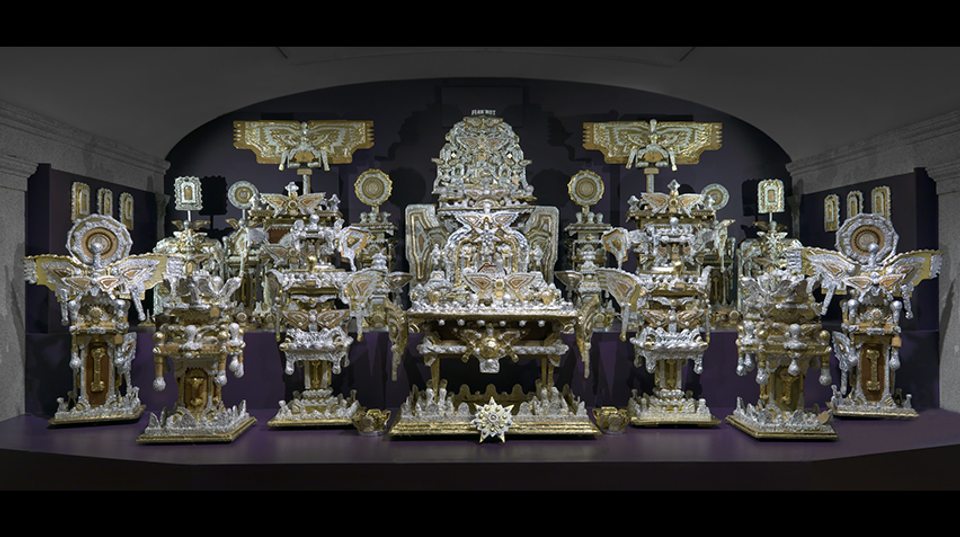James Hampton
- Born
- Elloree, South Carolina, United States
- Died
- Washington, District of Columbia, United States
- Biography
Little is known about James Hampton, despite the grandeur of his self-chosen title, "Director, Special Projects for the State of Eternity." He was born in 1909 in Elloree, South Carolina, a small community of predominantly African-American sharecroppers and tenant farmers. His father, a gospel singer and self-ordained Baptist minister, left his wife and four children to pursue his itinerant calling.
In 1928, when he was nineteen, Hampton moved to Washington, D.C., to live with an older brother. Drafted into the Army in 1942, he served with a segregated unit that maintained airstrips in Saipan and Guam during World War II. Hampton returned to Washington in 1945, and began working a year later as a janitor for the General Services Administration until his death in 1964. Although he expressed interest in finding "a holy woman," to assist with his life’s work he never married and had few close friends.
Hampton was raised as a fundamentalist Baptist, but he disliked the concept of a denominational God and attended a variety of the city’s churches. As early as 1931, Hampton believed that he began receiving visions from God, and by 1945 it appears he had made one small, shrine-like object while stationed on Guam. This piece became part of his larger work, and is now placed in front of the center pulpit.
His work on The Throne of the Third Heaven of the Nations Millennium General Assembly probably began in earnest around 1950, when he rented a garage in his northwest Washington neighborhood, which was also the city's center of African-American business, religious, and night life.
Although a humble man, Hampton often referred to himself as "St. James." He may have considered himself a prophet like John, the author of The Book of Revelation, the biblical writing that inspired Hampton's belief in the Second Coming of Christ and his desire to build The Throne as a monument to the return of Christ to earth.
Hampton worked almost every day on his project, often starting his work at midnight after completing his janitorial duties. He continued his efforts until he died in 1964. The Throne was discovered and brought to the public's attention after his death. It is most likely Hampton's monument to his faith was never completely finished.
Exhibition Label, Smithsonian American Art Museum, 2006
- Artist Biography
The artistic gifts of James Hampton were virtually unknown until shortly after his death. Hampton was born in the small rural community of Elloree, South Carolina. His father was an itinerant, self-proclaimed Baptist minister and gospel singer who deserted his wife and four young children to follow his calling.
When Hampton was around nineteen years old he moved to Washington, D.C., to join an older brother. From 1939 to 1942 Hampton worked as a short-order cook in several local cafes, and later joined the federal government labor force. Details concerning Hampton's educational background are sketchy. Presumably he attended the local schools in Elloree, South Carolina. On an application for federal employment in Washington, Hampton claimed to have attended an African-American high school in the District of Columbia through the tenth grade. There are no records, however, of Hampton's attendance at such a school.
In 1943 Hampton was inducted into the United States Army and served with the 385th Aviation Squadron in Texas, Hawaii, and the jungles of Saipan and Guam. His unit was noncombatant, and drew duties that consisted largely of carpentry and maintenance of air strips. Following his honorable discharge from the army in 1945, Hampton returned to Washington. In 1946 he was hired by the General Services Administration as a janitor. He remained in that position until his death.
Additional facts concerning Hampton's life are scarce. He never married, lived alone in a small apartment in a row house in northwest Washington, and was described as a small, bespectacled, soft-spoken recluse with few friends. James Hampton was totally dedicated to his "vision", a "vision" that almost defies artistic classification yet produced an outstanding example of religious sculpture. In November 1964, Hampton died of cancer in Washington at the age of fifty-three.
Regenia A. Perry Free within Ourselves: African-American Artists in the Collection of the National Museum of American Art (Washington, D.C.: National Museum of American Art in Association with Pomegranate Art Books, 1992)
Exhibitions
Related Posts
















